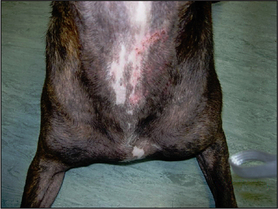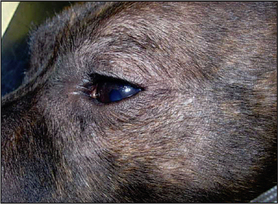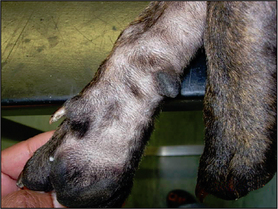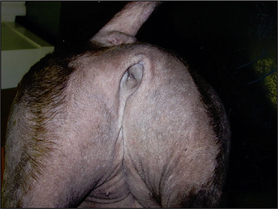6 Atopic dermatitis
INTRODUCTION
• Typical distribution of pruritus and lesions (facial, pedal, ventral and may involve perianal area)
CASE HISTORY
The main points of interest in the history were:
• The pruritus had been intermittent; it was worse in the summer but was also present during the winter months.
• There were no other animals in the house, but casual contact with dogs in the parks and with relatives’ pets.
CLINICAL EXAMINATION
The significant clinical findings in this case were:
• Hypotrichosis and erythema of the flexural aspects of the carpi and the extensor aspects of the elbows (Fig. 6.3).
CASE WORK-UP
Diagnostic tests: The following diagnostic tests were performed:
• Skin scrapings, hair plucks and coat brushings, which were negative for Demodex canis and Sarcoptes canis mites.
• Examination of tape strip preparations from the ventral neck, which showed Malassezia pachydermatis and coccoid bacteria. Both organisms play a secondary role in the pathogenesis of the dermatitis and should therefore be treated.
• Sarcoptes scabiei mites are not always seen on skin scrapings in cases of scabies and likewise a failure to identify fleas or flea faeces on examination does not rule out the involvement of flea allergy dermatitis. Additionally, there was evidence of secondary yeast and bacterial infection that may have been contributing significantly to the level of pruritus. Therefore, despite the fact that this case satisfied sufficient major and minor criteria for the diagnosis of atopic dermatitis, it was important to rule out ectoparasitic disease and resolve the secondary yeast and bacterial infections before proceeding with the investigations into the underlying allergy. Prior treatment of concurrent and secondary diseases allows a baseline level of pruritus to be established before starting a diet trial.
Therapeutic trials: Initially, the following therapeutic trials were performed concurrently:
• The Malassezia dermatitis was treated by three times weekly baths with a shampoo containing 2% miconazole/2% chlorhexidine.
• To definitively rule out scabies or flea involvement, selamectin was applied three times at 2-weekly intervals, and the home was treated with a spray containing a combination of permethrin and pyriproxyfen.
Stay updated, free articles. Join our Telegram channel

Full access? Get Clinical Tree






